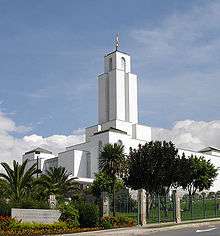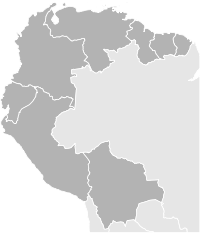Cochabamba Bolivia Temple
The Cochabamba Bolivia Temple is the 82nd operating temple of The Church of Jesus Christ of Latter-day Saints (LDS Church).
| Cochabamba Bolivia Temple | ||||||||||||||||||||||||||||||||||||||||||||
|---|---|---|---|---|---|---|---|---|---|---|---|---|---|---|---|---|---|---|---|---|---|---|---|---|---|---|---|---|---|---|---|---|---|---|---|---|---|---|---|---|---|---|---|---|
 | ||||||||||||||||||||||||||||||||||||||||||||
| Number | 82 | |||||||||||||||||||||||||||||||||||||||||||
| Dedicated | 30 April 2000 by Gordon B. Hinckley | |||||||||||||||||||||||||||||||||||||||||||
| Site | 6.51 acres (2.6 hectares) | |||||||||||||||||||||||||||||||||||||||||||
| Floor area | 33,300 sq ft (3,090 m2) | |||||||||||||||||||||||||||||||||||||||||||
| Preceded by | Reno Nevada Temple | |||||||||||||||||||||||||||||||||||||||||||
| Followed by | Tampico Mexico Temple | |||||||||||||||||||||||||||||||||||||||||||
| Official website • News & images | ||||||||||||||||||||||||||||||||||||||||||||
| ||||||||||||||||||||||||||||||||||||||||||||
Bolivia's first convert to the LDS Church was baptized in December 1964, a month after missionaries first arrived. Forty-four years later there were over 158,000 members across the country.[1]
History
In 1995, the church announced that a temple would be built in the Bolivian city of Cochabamba. The next year, church president Gordon B. Hinckley presided over the groundbreaking. He addressed the 4,000 people gathered during one of the heaviest rainstorms the area had seen in ten years. He addressed the gathering, "My beloved and wet brothers and sisters".[2]
Before the temple was dedicated it was open for one week to allow the public to tour the temple. Originally the temple open house had been scheduled for two weeks, but because of civil unrest in the city of Cochabamba, due to an ill-fated attempt to privatize the municipal water supply (Cochabamba protests of 2000), the first week was cancelled. LDS Church leaders were pleased when nearly 65,000 people toured the temple, coming close to the goal of 75,000. Because of the open house, over 2,200 people requested to be visited by the Mormon missionaries.
Hinckley dedicated the Cochabamba Bolivia Temple in four sessions on April 30, 2000. In the dedicatory prayer, Hinckley recognized the founder of Bolivia, Simón Bolívar, who died the year the church was organized.
The Cochabama Bolivia Temple is of classic modern design reflecting the Bolivian culture. The exterior is finished with a blend of hand-hewn granite and plaster. A statue of the angel Moroni tops the single tower. It has a total of 33,302 square feet (3,093.9 m2), two ordinance rooms, and three sealing rooms.
In 2020, the Cochabamba Bolivia Temple was closed in response to the coronavirus pandemic.[3]
See also
- Jay E. Jensen, temple president (2013–)
- Comparison of temples of The Church of Jesus Christ of Latter-day Saints
- List of temples of The Church of Jesus Christ of Latter-day Saints
- List of temples of The Church of Jesus Christ of Latter-day Saints by geographic region
- Temple architecture (Latter-day Saints)
- The Church of Jesus Christ of Latter-day Saints in Bolivia
References
- "Bolivia: Statistics by Country: Facts and Statistics", Newsroom, Church News, 31 December 2011
- "News of the Church: President Hinckley Visits South America, Florida, Washington, D.C.", Ensign: 73, February 1997
- Stack, Peggy Fletcher. "All Latter-day Saint temples to close due to coronavirus", The Salt Lake Tribune, 26 March 2020. Retrieved on 28 March 2020.
Additional reading
- Hart, John L. (Nov 23, 1996), "Prophet breaks ground for new temples", Church News
- Hart, John L. (Sep 20, 1997), "Faith paved way for temple in Bolivia", Church News
- "Temples now planned in 30 nations", Church News, March 28, 1998
- "Dedication dates set for Reno and Cochabamba temples", Church News, March 25, 2000
- "Facts and figures: Cochabamba Bolivia Temple", Church News, May 13, 2000
- "Country information: Bolivia", Church News, Jan 25, 2010
- Johnston, Jerry; Hart, John L. (May 13, 2000), "Worthy of the heart of a people", Church News
- Swensen, Jason (May 15, 2010), "'City in the Clouds' — Devotion defines members from world's highest capital city", Church News
